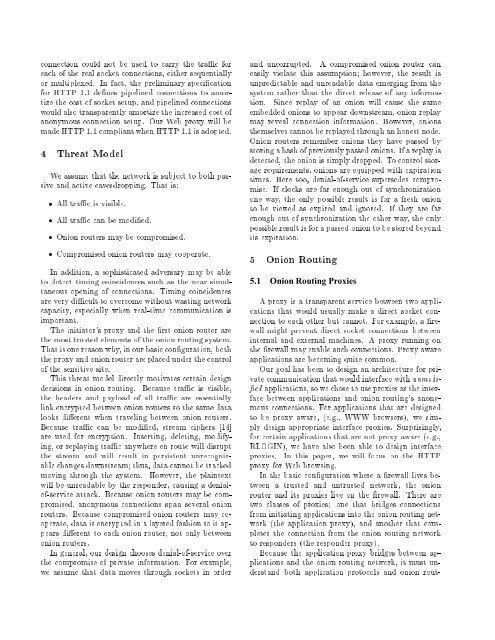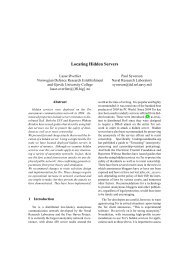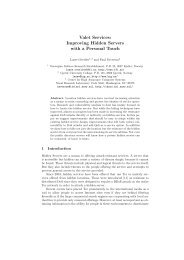Anonymous Connections and Onion Routing
Anonymous Connections and Onion Routing
Anonymous Connections and Onion Routing
You also want an ePaper? Increase the reach of your titles
YUMPU automatically turns print PDFs into web optimized ePapers that Google loves.
connection could not be used to carry the trac for<br />
each of the real socket connections, either sequentially<br />
or multiplexed. In fact, the preliminary specication<br />
for HTTP 1.1 denes pipelined connections to amortize<br />
the cost of socket setup, <strong>and</strong> pipelined connections<br />
would also transparently amortize the increased cost of<br />
anonymous connection setup. Our Web proxy will be<br />
made HTTP 1.1 compliant when HTTP 1.1 is adopted.<br />
4 Threat Model<br />
We assume that the network is subject to both passive<br />
<strong>and</strong> active eavesdropping. That is:<br />
All trac is visible.<br />
All trac can be modied.<br />
<strong>Onion</strong> routers may be compromised.<br />
Compromised onion routers may cooperate.<br />
In addition, a sophisticated adversary may be able<br />
to detect timing coincidences such as the near simultaneous<br />
opening of connections. Timing coincidences<br />
are very dicult to overcome without wasting network<br />
capacity, especially when real-time communication is<br />
important.<br />
The initiator's proxy <strong>and</strong> the rst onion router are<br />
the most trusted elements of the onion routing system.<br />
That is one reason why, in our basic conguration, both<br />
the proxy <strong>and</strong> onion router are placed under the control<br />
of the sensitive site.<br />
This threat model directly motivates certain design<br />
decisions in onion routing. Because trac is visible,<br />
the headers <strong>and</strong> payload of all trac are essentially<br />
link encrypted between onion routers so the same data<br />
looks dierent when traveling between onion routers.<br />
Because trac can be modied, stream ciphers [14]<br />
are used for encryption. Inserting, deleting, modifying,<br />
or replaying trac anywhere en route will disrupt<br />
the stream <strong>and</strong> will result in persistent unrecognizable<br />
changes downstream; thus, data cannot be tracked<br />
moving through the system. However, the plaintext<br />
will be unreadable by the responder, causing a denialof-service<br />
attack. Because onion routers may be compromised,<br />
anonymous connections span several onion<br />
routers. Because compromised onion routers may cooperate,<br />
data is encrypted in a layered fashion so it appears<br />
dierent to each onion router, not only between<br />
onion routers.<br />
In general, our design chooses denial-of-service over<br />
the compromise of private information. For example,<br />
we assume that data moves through sockets in order<br />
<strong>and</strong> uncorrupted. A compromised onion router can<br />
easily violate this assumption; however, the result is<br />
unpredictable <strong>and</strong> unreadable data emerging from the<br />
system rather than the direct release of any information.<br />
Since replay of an onion will cause the same<br />
embedded onions to appear downstream, onion replay<br />
may reveal connection information. However, onions<br />
themselves cannot be replayed through an honest node.<br />
<strong>Onion</strong> routers remember onions they have passed by<br />
storing a hash of previously passed onions. If a replayis<br />
detected, the onion is simply dropped. To control storage<br />
requirements, onions are equipped with expiration<br />
times. Here too, denial-of-service supersedes compromise.<br />
If clocks are far enough out of synchronization<br />
one way, the only possible result is for a fresh onion<br />
to be viewed as expired <strong>and</strong> ignored. If they are far<br />
enough out of synchronization the other way, the only<br />
possible result is for a passed onion to be stored beyond<br />
its expiration.<br />
5 <strong>Onion</strong> <strong>Routing</strong><br />
5.1 <strong>Onion</strong> <strong>Routing</strong> Proxies<br />
A proxy is a transparent service between two applications<br />
that would usually make a direct socket connection<br />
to each other but cannot. For example, a rewall<br />
might prevent direct socket connections between<br />
internal <strong>and</strong> external machines. A proxy running on<br />
the rewall may enable such connections. Proxy aware<br />
applications are becoming quite common.<br />
Our goal has been to design an architecture for private<br />
communication that would interface with unmodi-<br />
ed applications, so we chose to use proxies as the interface<br />
between applications <strong>and</strong> onion routing's anonymous<br />
connections. For applications that are designed<br />
to be proxy aware, (e.g., WWW browsers), we simply<br />
design appropriate interface proxies. Surprisingly,<br />
for certain applications that are not proxy aware (e.g.,<br />
RLOGIN), we have also been able to design interface<br />
proxies. In this paper, we will focus on the HTTP<br />
proxy for Web browsing.<br />
In the basic conguration where a rewall lives between<br />
a trusted <strong>and</strong> untrusted network, the onion<br />
router <strong>and</strong> its proxies live on the rewall. There are<br />
two classes of proxies: one that bridges connections<br />
from initiating applications into the onion routing network<br />
(the application proxy), <strong>and</strong> another that completes<br />
the connection from the onion routing network<br />
to responders (the responder proxy).<br />
Because the application proxy bridges between applications<br />
<strong>and</strong> the onion routing network, it must underst<strong>and</strong><br />
both application protocols <strong>and</strong> onion rout-





